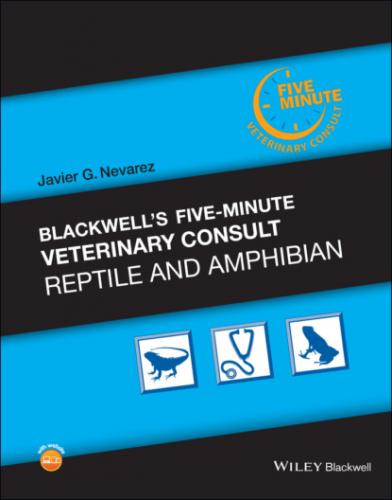Omnivores and carnivores can be fed whole prey still containing liver, or for semiaquatic turtles, can offer extruded diet with correct form of vitamin A.
Supportive feeding, including esophageal feeding tubes may be needed until the reptile feels better and can actually see the food.
For herbivores, feed plenty of leafy greens and red/orange/yellow vegetables.
Treatment for insectivores is more complex.
Invertebrates store retinols in the retina only, so invertebrates (or juvenile forms) without eyes have no vitamin A.
Dusting invertebrates must be done immediately before feeding, as the vitamin powder is usually often self‐groomed off the invertebrate before the reptile has ingested it.
Gut‐loading guidelines are still controversial but seem to still be the best option—especially consider the Li diet (see Suggested Reading).
Consider feeding non‐toxic, wild‐caught invertebrates, as they generally have much higher levels of vitamin A than captive‐raised invertebrates.
CLIENT EDUCATION/HUSBANDRY RECOMMENDATIONS
Proper education about correct diet for the species.
Discuss correct formulation of vitamin A for the species.
Correct invertebrates to offer and how to supplement them.
Clear explanation of differences between water‐soluble and fat‐soluble vitamins.
DRUG(S) OF CHOICE
Parenteral treatment or oral supplementation of retinol forms to herbivores should be avoided.
Use dietary carotenoids (non‐beta carotene) instead.
For omnivorous, carnivorous, and insectivorous reptiles, parenteral vitamin A (usually has vitamin D3 as well): 500–5,000 iu/kg IM q7–14d for up to 4 treatments.
Dosing must be done carefully to avoid over supplementation with vitamin A in the retinol form.
Other treatment focuses on managing with systemic antibiotics/antifungals for secondary infections.
Judicious topical use of silver sulfadiazine cream for epidermal ulcers can help.
Removal of conjunctiva plugs or flushing nasolacrimal ducts (when present) can be beneficial symptomatic treatment.
PRECAUTIONS/INTERACTIONS
Vitamin A interacts with other fat‐soluble vitamins (D, E, K).
PATIENT MONITORING
Re‐evaluate for improvement of clinical signs.
Review owner’s diet plan
Repeat liver biopsy if feasible
EXPECTED COURSE AND PROGNOSIS
Usually chronic, clinical resolution can take several months with most manifestations resolving, though renal damage may be permanent.
COMMENTS
N/A
ZOONOTIC POTENTIAL
N/A
SYNONYMS
N/A
ABBREVIATIONS
IM = intramuscular
UVB = ultraviolet B
Suggested Reading
1 Chen LP, Huang CH. Estimation of dietary vitamin A requirement of juvenile soft‐ shelled turtle, Pelodiscus sinensis. Aquacult Nutr 2015;21:457–463.
2 Li H, Vaughan MJ, Browne RK. A complex enrichment diet improves growth and health in the endangered Wyoming toad (Bufo baxteri). Zoo Biol 2009;28:197–213.
3 Mans C, Braun J. Update on common nutritional disorders of captive reptiles. Vet Clin North Am Exot Anim Pract 2014;17(3):369–395.
4 Miller EA, Green SL, Otto GM, Bouley DM. Suspected hypovitaminosis A in a colony of captive green anoles (Anolis carolinensis). Contemp Top Lab Anim Sci 2001;40:18–20.
Author Eric Klaphake, DVM, DACZM
Hypovitaminosis B
DEFINITION/OVERVIEW
Hypovitaminosis B generally refers to hypothiaminosis and is a health concern in reptiles that are fed fish—whether live or frozen thawed. Other cases have been reported in herbivorous reptiles and reptiles fed vitamin supplements lacking in thiamine.
ETIOLOGY/PATHOPHYSIOLOGY
In humans, thiamine deficiency can occur rapidly and advance to metabolic coma and death; causes being malnutrition, a diet high in thiaminase‐rich foods (raw freshwater fish, raw shellfish, ferns), chronic gastrointestinal diseases, and diabetes mellitus.
Thiamine derivatives and thiamine‐ dependent enzymes are present in all cells, but the nervous system is very sensitive, leading to nerve fiber myelin sheath degeneration causing necrotizing encephalopathy and peripheral neuritis.
Bilateral vision loss due to optic neuropathy can occur.
Thiamine is a water‐soluble vitamin synthesized by bacteria, fungi, and plants.
Captive fish‐eating garter snakes and semi‐aquatic turtles, and captive and free‐ ranging crocodilians are most commonly affected.
Feeding fish high in thiaminase—goldfish and fathead minnow, improperly thawed fish (thawing too slowly), or fish that has been frozen a long time can all be factors.
Some frozen thawed vegetables containing phytothiaminases lead to thiamine deficiency in green iguanas.
Insectivorous anoles developed thiamine deficiency due to lack of any thiamine in the multivitamin supplement because of extensive storage before use.
Thiamine is a rapidly deteriorating vitamin so it is important to ensure that supplements are stored and used properly.
SIGNALMENT/HISTORY
Fish as primary diet
Thawed frozen vegetables
Using same container of vitamin supplement/powder beyond expiration date or past 6
